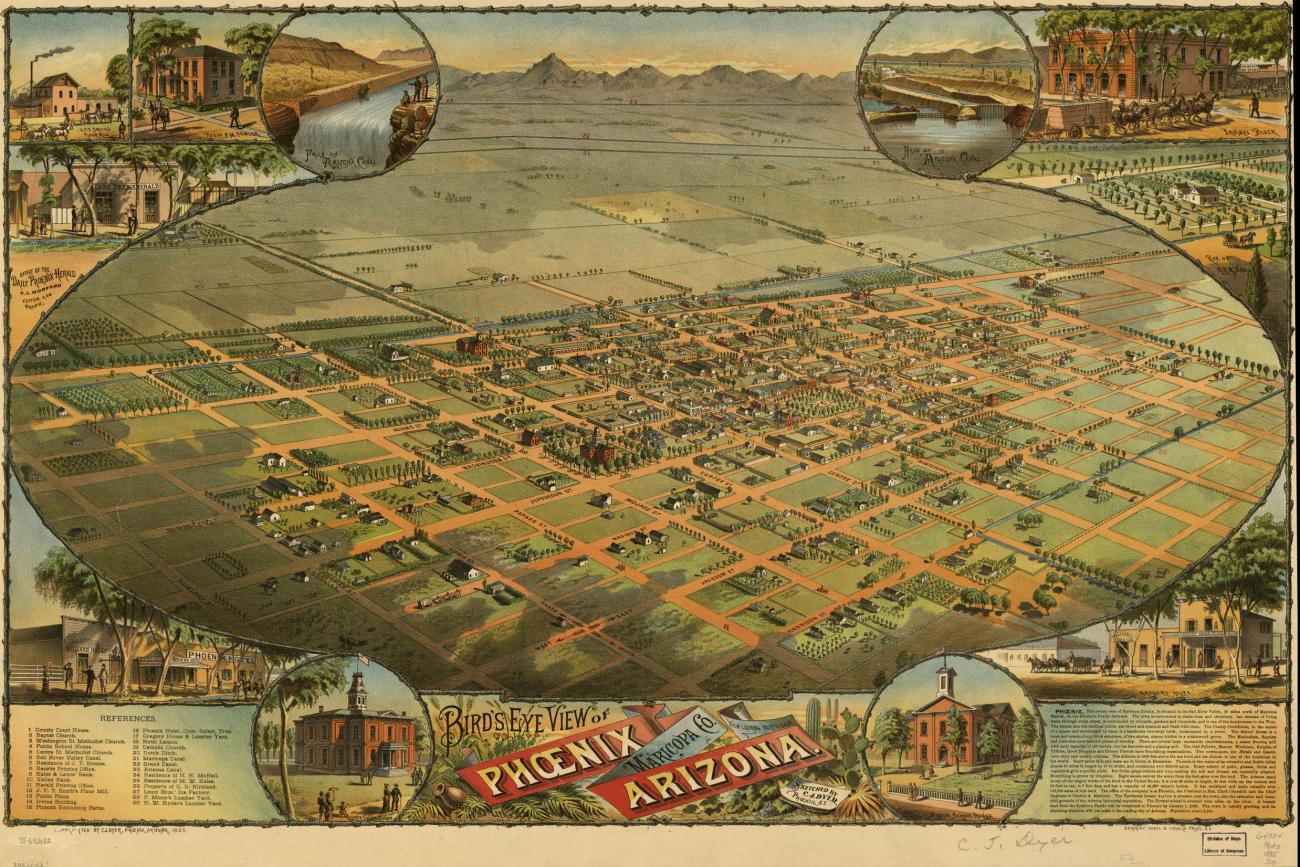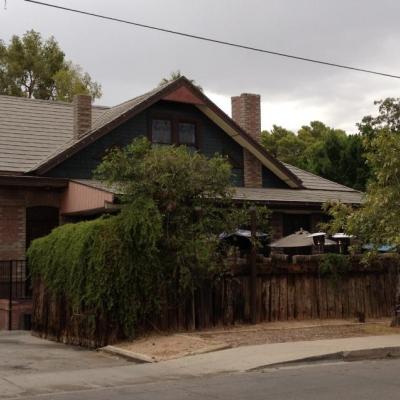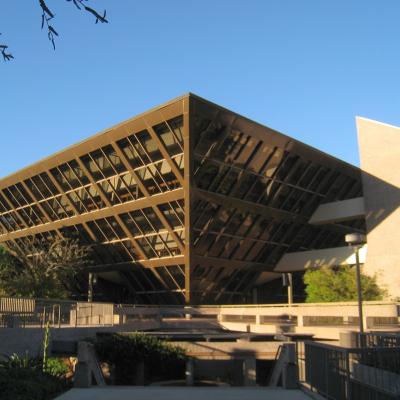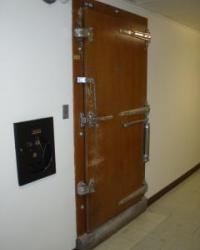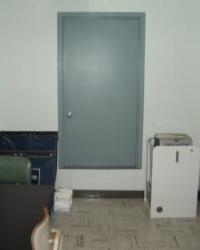Mystery Doors, Feathered Revenants, and Mummified Senators: Legendry from the Dark Heart of Hayden's Ferry
Sometimes legends make reality, and become more useful than the facts.
—Salman Rushdie
Several weeks ago, I took a brief stroll around the abandoned shell of Monti's La Casa Vieja on First Street and Mill. What a sad sight it was. In a city that seems intent on relegating its architectural heritage to rubble and memory, Monti's stalwartly resisted the resolute crawl of corporatization in once seedy but always interesting Old Town Tempe.
For years, it had been a gathering spot for our family. My grandparents would come up from their citrus groves in Chandler Heights, my grandpa gruff and stoic in his straw Stetson and bola tie, my grandma wearing one of her ubiquitous flowered hats and smelling of rosewater, stuffing the contents of the bread basket in her purse at meal's end. It was at one of our get-togethers that my mother spoke of the doors on the northwest face of the Old House. In her day, she told us, these doors led to cubicles where the "bad girls" at the university (then, Arizona State College) supplemented their incomes. She didn't go into the details.
My mother had plenty of stories about Tempe in the mid-1940s, when she attended what would become ASU: The screened sleeping porches in the dorms, the obligatory whitewashing of the big letter on A mountain by incoming freshmen, dorm mother Sally Hayden, dour and ever on the lookout for attempts to smuggle boys into the rooms of her charges.
These, however, were more in the realm of oral history than the account of the doors, which smacks of what folklorists call legend—that is, narratives, full or fragmentary, involving remarkable happenings that challenge belief. Never verifiable but ever plausible, legends draw their energy from a dialog between certainty and doubt, and their endurance from the extraordinary nature of their subject matter. My mother's revelation may have been more a rumor than an actual legend as it had little narrative content, but its peculiar irony, prurient appeal, and relevance to student concerns (what extremes might I go to when tuition and expenses come due?) would beg discussion through the construction of compelling narratives. Perhaps these would have their origins in FOAF (in folklorese, friend of a friend) accounts of dangerous liaisons with the keepers of the doors, or in observations of peculiar goings-on from eyewitness narrators.
My Uncle Chuck would occasionally drive in from California to join us at Monti's. He had been a flight instructor in WWII and afterwards flew crop dusters in the Gila Valley. He told stories of the latter experience that were cautionary in nature—of pilots accidentally getting too close to the spinning blades of planes, or discovering rattlesnakes nesting under the seat cushions they had placed in the shade of their wings in anticipation of a nap. Had he been present when these events happened? Had he heard them from other pilots, who perhaps had heard them from other pilots still? Or had he invented his stories from whole cloth to goof a credulous nephew, as uncles will do? One man's prank can evolve into another's legend, and with multiple generations of tellings, becomes enriched with fascinating possibility as the prankster stands in the shadows, contemplating and relishing what he has set loose.
Ghosts about Town
To many, legendry is associated with ghostlore. The legendary potential of my uncle's accounts could easily generate tales of revenant manifestation—a headless duster pilot, victim of a propeller accident, haunting an abandoned airfield in Eloy or Maricopa, accompanied by a comrade wailing mournfully as he vies in eternal combat with an angry diamondback. And perhaps one of the soiled sisters of Monti's, murdered by a client (you fill in the backstory), wanders the forlorn gothic spaces of the Old House as we speak.
Casey Moore's, Tempe's premier venue for things supernatural, boasts such a legend. It tells of a woman boarder (or prostitute, depending on the variant) who was strangled in an upstairs room, which she haunts to this day. Before its service as a restaurant, boarding house, and (some say) brothel, Casey Moore's was the residence of the Moeur family. My mother lived there briefly when she attended the State College. She had been invited by her friend Joanne, the granddaughter of Mary Wilson Moeur who, in ghostly form, has been seen dancing with her equally ghostly husband on the restaurant's upper floor. Joanne, my mother told me, claimed that there are no ghosts in the Moeur House, but many who have staffed the restaurant over the years say otherwise.
Every now and then, on the corner of Ninth and Ash just south of the Moeur House, I have to defer to a brace of peacocks, elegantly appointed and persistently territorial of the crosswalks in the four way stop. Escapees, no doubt, from the lair of a local urban farmer, but my sister and I are convinced that one of them is our reincarnated mother, former neighborhood resident and inveterate clothes horse in her middle years. Chickens also frequent the intersection. We've concluded that our brother lives in one of these birds. Back in the day, he played guitar in a local country/western band called The Legendary Thunderchicken. The musicians, jokers to a man, would place a caged chicken on stage wherever they performed. Once, it got loose and was nearly trampled by beer-sodden bluegrass dancers. Karma will have its due, and families their legends.
While Thunderchicken was making the rounds of Tempe's dive bars with their tormented mascot, I was doing my undergraduate work at the University. Downtown, the new city hall had just been built. Its inverted pyramid design seemed to reflect the recent popularity of the Pyramid Power movement. I recall the owner of a local bicycle shop riding the streets of Old Town wearing a tubular, pyramid-shaped plastic hat through which, he told me, he had achieved an astonishing degree of focus.
It was said that the body of a dead bird could be suspended within such a structure and survive for years without decaying. Somebody made the connection, and the story went around that the upside-down pyramid had been constructed to contain and forever preserve the body of former senator Carl Hayden, born in the Casa Vieja and a duffer several times over before he finally died. I haven't heard the tale since then, but for a time Tempe had its very own Walt Disney, sans cryonics and spending eternity in digs far less exotic than the secret cavern that lies below The Pirates of the Caribbean in Disney Anaheim.
Many years later when I came back to ASU to attend grad school, the old Gentle Strength Co-op on the corner of Ash and University provided a home for the ancient and arcane mysteries of the Granolakultur of the 60s and 70s. One denizen in particular tempted legend by wearing an impossibly voluminous 1920s cap over a great mop of gray hair. Word had it that he raised alfalfa sprouts for the co-op's produce department in this unlikely greenhouse. A vacant lot lies on the corner where the co-op once stood, and I wonder if on moonless nights you might not see the spirit of this generous gardener wandering its grounds in search of salads and open-faced toasted cheese sandwiches.
Enduring Mysteries at Home
But let us venture to our home ground. In the SS building (a.k.a., The Leaning Tower of Social Sciences), stories circulate of the constant movement of faculty, staff, and students about the four corners of the structure to establish stability and thus counter imminent collapse from subsidence. And just to the east, in the bowels of the LS building, you will find an imposing door crafted from a thick maple slab and secured with more stainless steel hinges and locks than necessary for any level of security. What transpires in the eldritch caverns that lay beyond its fastness? Surely, questionable experiments and investigations into the unthinkable. This is, after all, Life Sciences—a curious discipline with priorities and protocols that confound the imagination of the humanist.
And what of our very own mystery door in Language and Literature? You know the one I'm talking about, on the southernmost point of the third floor. It is locked fast, and no one I've spoken to in my twenty years in the department has ever seen it opened. In the 1990s, TAs on the floor theorized that it concealed a great detention center that housed PhD candidates who were slow in finishing their programs. Down the hall, the graduate lounge reveals a cognate tale. For a brief period, folks returning to work on Monday mornings would find the lounge strewn with pint bottles and potato chip wrappers, and noticeably redolent of street funk. The paranormal manifestation of a ghostly visitor, or a former grad student in need of a flop and a dram?
And we ourselves should beware lest we become entrapped by folk dynamics that lie beyond our control. Several years ago, I learned that some of my former students had created a Facebook page under my name. For the profile picture, they had photo-shopped my head (presumably, harvested from my faculty page portrait) on the naked-above-the-waste torso of a body builder, replete with tattoos and an excruciating array of piercings, chains, clamps, and rings. The page went on to illustrate my adventurous encounters with authors across the canon. In one, I (rather, the Shelleyan cyber-abomination of my profile pic) am with Edgar Allan Poe in the chamber of "The Raven," my arm around his shoulder. The page was short lived, and while I did grumble about its good-natured assault on my dignity, I do miss it. I'm thinking that given time, they would have had me riding with the scalp hunters of Cormac McCarthy's Blood Meridian.
As Fox Mulder reminds us, the truth is out there. The tellers and audiences of legendry will court truth but they will keep it at arm's length, for nothing would be sadder than to ruin a good story.
